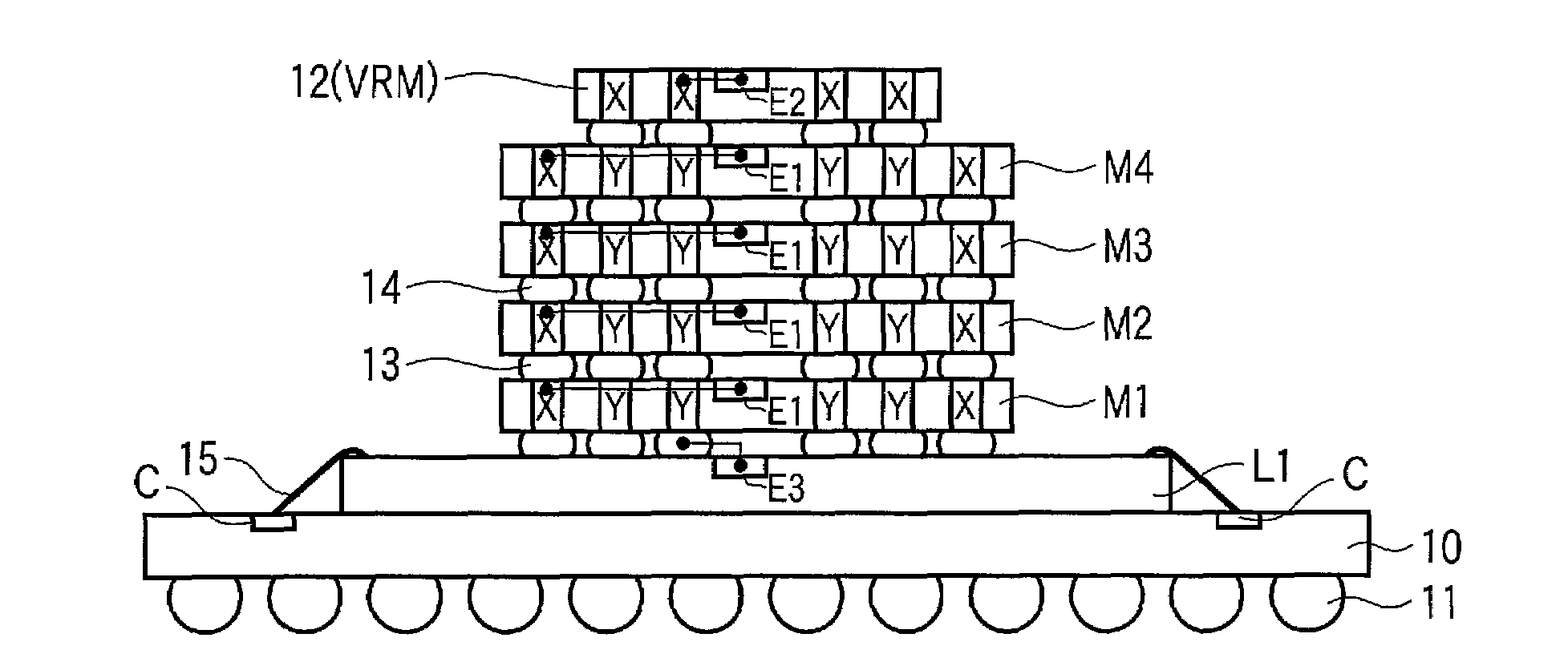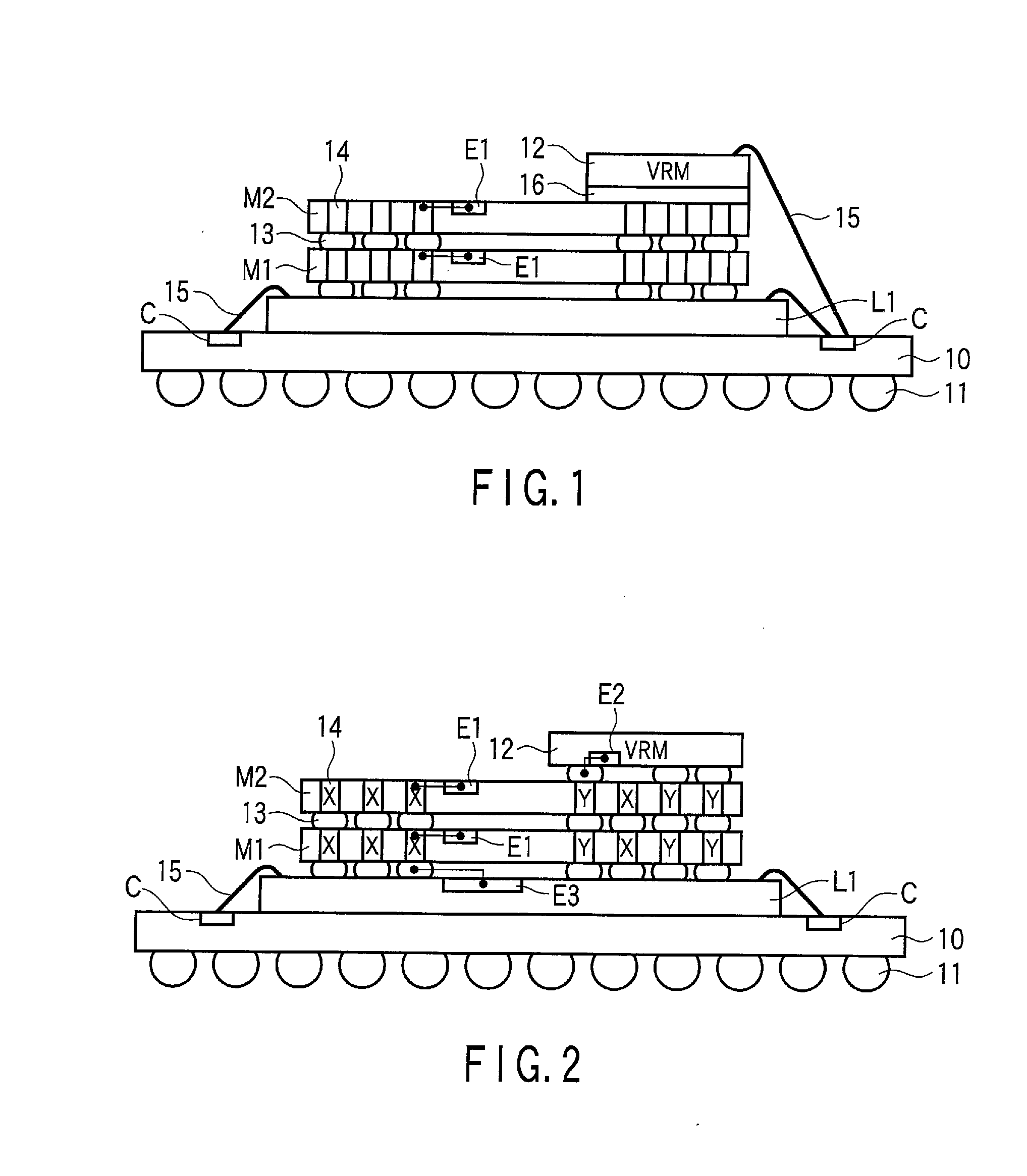Stacked-chip device
a technology of stacked chips and chips, applied in the direction of semiconductor devices, semiconductor/solid-state device details, electrical apparatus, etc., can solve the problems of increased production cost, performance decline, and inability to establish electrical connections
- Summary
- Abstract
- Description
- Claims
- Application Information
AI Technical Summary
Problems solved by technology
Method used
Image
Examples
embodiment
3. EMBODIMENT
(1) First Embodiment
[0046]FIG. 2 shows a through-silicon via according to a first embodiment of the invention.
[0047]Chips L1, M1, M2, and 12 having different functions are mounted on the package board 10. For example, the BGA terminal 11 is disposed in the lower surface of the package board 10.
[0048]Chip L1 is the control chip (for example, CPU). Control chip L1 is connected to the conductive line C on the package board 10 through the bonding wire 15.
[0049]Chips M1 and M2 are the memory chip. Memory chip M1 is stacked on control chip L1, and memory chip M2 is stacked on memory chip M1.
[0050]Chip 12 is the VRM chip. The VRM chip 12 is stacked on memory chip M2.
[0051]The bumps 13 are disposed between control chip L1 and memory chip M1, between memory chip M1 and memory chip M2, and between memory chip M2 and the VRM chip 12.
[0052]Memory chips M1 and M2 are the through-silicon-via chip. Each of memory chips M1 and M2 includes the semiconductor substrate, semiconductor inte...
second embodiment
(2) Second Embodiment
[0065]FIG. 3 shows a through-silicon via according to a second embodiment of the invention.
[0066]The second embodiment relates to an application example of the first embodiment.
[0067]TSV of the second embodiment differs from TSV of the first embodiment in the number of memory chips (M1 to M4) stacked on control chip L1 and the position of the VRM chip 12.
[0068]In TSV, there is no limitation to the number of memory chips stacked on control chip L1. In the second embodiment, four memory chips M1 to M4 are stacked on control chip L1. Preferably the number of memory chips stacked on control chip L1 is 2n (n is a natural number).
[0069]In the second embodiment, the VRM chip 12 is disposed in the centers of memory chips M1 to M4. The layouts of conductive layers 14(Y) that are the dummy through-silicon via in memory chips M1 to M4 are determined such that the VRM chip 12 can be disposed in the centers of memory chips M1 to M4.
third embodiment
(3) Third Embodiment
[0070]FIG. 4 shows a through-silicon via according to a third embodiment of the invention.
[0071]The third embodiment also relates to an application example of the first embodiment.
[0072]TSV of the third embodiment differs from TSV of the first embodiment in that control chip (for example, CPU) L1 is the through-silicon-via chip.
[0073]Control chip L1 includes the semiconductor substrate, semiconductor integrated circuit E3, and conductive layer 14(X). Semiconductor integrated circuit E3 is formed on one surface side of the semiconductor substrate. Conductive layer 14(X) is pierced from one surface side of the semiconductor substrate to the other surface side, and connected to semiconductor integrated circuit E3.
[0074]Semiconductor integrated circuit E3 in control chip L1 is connected to semiconductor integrated circuit E1 in each of memory chips M1 and M2 through conductive layer 14(X) in each of memory chips M1 and M2.
[0075]Semiconductor integrated circuit E3 in ...
PUM
 Login to View More
Login to View More Abstract
Description
Claims
Application Information
 Login to View More
Login to View More - R&D
- Intellectual Property
- Life Sciences
- Materials
- Tech Scout
- Unparalleled Data Quality
- Higher Quality Content
- 60% Fewer Hallucinations
Browse by: Latest US Patents, China's latest patents, Technical Efficacy Thesaurus, Application Domain, Technology Topic, Popular Technical Reports.
© 2025 PatSnap. All rights reserved.Legal|Privacy policy|Modern Slavery Act Transparency Statement|Sitemap|About US| Contact US: help@patsnap.com



